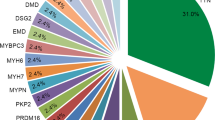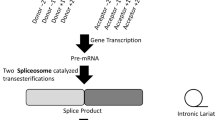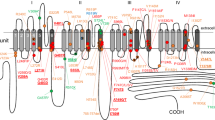Abstract
Catecholaminergic polymorphic ventricular tachycardia (CPVT) is predominantly caused by heterozygous missense variants in the cardiac ryanodine receptor, RYR2. However, many RYR2 missense variants are classified as variants of uncertain significance (VUS). We systematically re-evaluated all RYR2 variants in healthy individuals and those with CPVT or arrhythmia using the 2015 American College of Medical Genomics guidelines. RYR2 variants were identified by the NW Genomic Laboratory Hub, from the published literature and databases of sequence variants. Each variant was assessed based on minor allele frequencies, in silico prediction tools and appraisal of functional studies and classified according to the ACMG-AMP guidelines. Phenotype data was collated where available. Of the 326 identified RYR2 missense variants, 55 (16.9%), previously disease-associated variants were reclassified as benign. Application of the gnomAD database of >140,000 controls allowed reclassification of 11 variants more than the ExAC database. CPVT-associated RYR2 variants clustered predominantly between amino acid positions 3949–4332 and 4867–4967 as well as the RyR and IP3R homology-associated and ion transport domains (p < 0.005). CPVT-associated RYR2 variants occurred at more conserved amino acid positions compared with controls, and variants associated with sudden death had higher conservation scores (p < 0.005). There were five potentially pathogenic RYR2 variants associated with sudden death during sleep which were located almost exclusively in the C-terminus of the protein. In conclusion, control sequence databases facilitate reclassification of RYR2 variants but the majority remain as VUS. Notably, pathogenic variants in RYR2 are associated with death in sleep.
This is a preview of subscription content, access via your institution
Access options
Subscribe to this journal
Receive 12 print issues and online access
$259.00 per year
only $21.58 per issue
Buy this article
- Purchase on Springer Link
- Instant access to full article PDF
Prices may be subject to local taxes which are calculated during checkout



Similar content being viewed by others
References
Liu N, Ruan Y, Priori SG. Catecholaminergic polymorphic ventricular tachycardia. Prog Cardiovascular Dis. 2008;51:23–30.
Priori Silvia G, Napolitano C, Memmi M, Colombi B, Drago F, Gasparini M, et al. Clinical and molecular characterization of patients with catecholaminergic polymorphic ventricular tachycardia. Circulation. 2002;106:69–74.
Nyegaard M, Overgaard MT, Søndergaard MT, Vranas M, Behr ER, Hildebrandt LL, et al. Mutations in calmodulin cause ventricular tachycardia and sudden cardiac death. Am J Hum Genet. 2012;91:703–12.
Lahat H, Pras E, Olender T, Avidan N, Ben-Asher E, Man O, et al. A missense mutation in a highly conserved region of CASQ2 is associated with autosomal recessive catecholamine-induced polymorphic ventricular tachycardia in Bedouin families from Israel. Am J Hum Genet. 2001;69:1378–84.
Roux-Buisson N, Cacheux M, Fourest-Lieuvin A, Fauconnier J, Brocard J, Denjoy I, et al. Absence of triadin, a protein of the calcium release complex, is responsible for cardiac arrhythmia with sudden death in human. Hum Mol Genet. 2012;21:2759–67.
Devalla HD, Gélinas R, Aburawi EH, Beqqali A, Goyette P, Freund C, et al. TECRL, a new life-threatening inherited arrhythmia gene associated with overlapping clinical features of both LQTS and CPVT. EMBO Mol Med. 2016;8:1390–408.
Ohno S, Omura M, Kawamura M, Kimura H, Itoh H, Makiyama T, et al. Exon 3 deletion of RYR2 encoding cardiac ryanodine receptor is associated with left ventricular non-compaction. EP Europace 2014;16:1646–54.
Napolitano C, Bloise R, Memmi M, Priori SG. Clinical utility gene card for: Catecholaminergic polymorphic ventricular tachycardia (CPVT). Eur J Hum Genet. 2013;22:152.
Tester DJ, Medeiros-Domingo A, Will ML, Haglund CM, Ackerman MJ. Cardiac channel molecular autopsy: insights from 173 consecutive cases of autopsy-negative sudden unexplained death referred for postmortem genetic testing. Mayo Clin Proc. 2012;87:524–39.
George CH, Jundi H, Thomas NL, Fry DL, Lai FA. Ryanodine receptors and ventricular arrhythmias: Emerging trends in mutations, mechanisms and therapies. J Mol Cell Cardiol. 2007;42:34–50.
Karczewski KJ, Francioli LC, Tiao G, Cummings BB, Alföldi J, Wang Q, et al. Variation across 141,456 human exomes and genomes reveals the spectrum of loss-of-function intolerance across human protein-coding genes. 2019;531210. https://www.biorxiv.org/content/10.1101/531210v2.
Richards S, Aziz N, Bale S, Bick D, Das S, Gastier-Foster J, et al. Standards and guidelines for the interpretation of sequence variants: a joint consensus recommendation of the American College of Medical Genetics and Genomics and the Association for Molecular Pathology. Genet Med. 2015;17:405–24.
Landrum MJ, Lee JM, Benson M, Brown G, Chao C, Chitipiralla S, et al. ClinVar: public archive of interpretations of clinically relevant variants. Nucleic Acids Res. 2016;44:D862–D8.
Stenson PD, Mort M, Ball EV, Shaw K, Phillips A, Cooper DN. The Human Gene Mutation Database: building a comprehensive mutation repository for clinical and molecular genetics, diagnostic testing and personalized genomic medicine. Hum Genet. 2014;133:1–9.
Denham NC, Pearman CM, Ding WY, Waktare J, Gupta D, Snowdon R, et al. Systematic re-evaluation of SCN5A variants associated with Brugada syndrome. J Cardiovascular Electrophysiol. 2019;30:118–27.
Whiffin N, Minikel E, Walsh R, O’Donnell-Luria AH, Karczewski K, Ing AY, et al. Using high-resolution variant frequencies to empower clinical genome interpretation. Genet Med. 2017;19:1151.
Wayne Chen SR, Li P, Zhao M, Li X, Zhang L. Role of the proposed pore-forming segment of the Ca2+ Release Channel (Ryanodine Receptor) in Ryanodine Interaction*. Biophysical J. 2002;82:2436–47.
George CH, Jundi H, Thomas NL, Scoote M, Walters N, Williams AJ, et al. Ryanodine receptor regulation by intramolecular interaction between cytoplasmic and transmembrane domains. Mol Biol Cell. 2004;15:2627–38.
Verrier RL, Josephson ME. Impact of sleep on arrhythmogenesis. Circ Arrhythm Electrophysiol. 2009;2:450–9.
de Vries LJ, Géczy T, Szili-Torok T. Sleep medications containing melatonin can potentially induce ventricular arrhythmias in structurally normal hearts: a 2-patient report. J Cardiovasc Pharm. 2017;70:267–70.
Tooley GA, Armstrong SM, Norman TR, Sali A. Acute increases in night-time plasma melatonin levels following a period of meditation. Biol Psychol. 2000;53:69–78.
Bagnall RD, Weintraub RG, Ingles J, Duflou J, Yeates L, Lam L, et al. Study of sudden cardiac death among children and young adults. N. Engl J Med. 2016;374:2441–52.
Findlay GM, Daza RM, Martin B, Zhang MD, Leith AP, Gasperini M, et al. Accurate classification of BRCA1 variants with saturation genome editing. Nature. 2018;562:217–22.
Acknowledgements
This work was funded by a British Heart Foundation PhD studentship to DO. WGN is supported by the Manchester NIHR BRC (IS-BRC-1215–20007). The authors would like to thank the Genome Aggregation Database (gnomAD) and the groups that provided exome and genome variant data to this resource. A full list of contributing groups can be found at https://gnomad.broadinstitute.org/about.
Author information
Authors and Affiliations
Corresponding author
Ethics declarations
Conflict of interest
The authors declare that they have no conflict of interest.
Additional information
Publisher’s note Springer Nature remains neutral with regard to jurisdictional claims in published maps and institutional affiliations.
Rights and permissions
About this article
Cite this article
Olubando, D., Hopton, C., Eden, J. et al. Classification and correlation of RYR2 missense variants in individuals with catecholaminergic polymorphic ventricular tachycardia reveals phenotypic relationships. J Hum Genet 65, 531–539 (2020). https://doi.org/10.1038/s10038-020-0738-6
Received:
Revised:
Accepted:
Published:
Issue Date:
DOI: https://doi.org/10.1038/s10038-020-0738-6
This article is cited by
-
Clinical impact of rare variants associated with inherited channelopathies: a 5-year update
Human Genetics (2022)
-
“Ryanopathies” and RyR2 dysfunctions: can we further decipher them using in vitro human disease models?
Cell Death & Disease (2021)
-
Targeted next-generation sequencing identifies the disruption of the SHANK3 and RYR2 genes in a patient carrying a de novo t(1;22)(q43;q13.3) associated with signs of Phelan-McDermid syndrome
Molecular Cytogenetics (2020)



